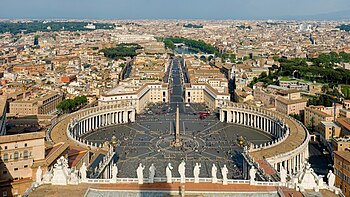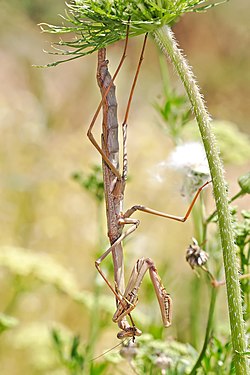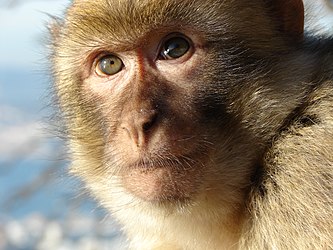Wikipedia:Picture of the day/September 2007: Difference between revisions
NotARealWord (talk | contribs) Removed profane vandalism |
mNo edit summary |
||
| (One intermediate revision by one other user not shown) | |||
| Line 36: | Line 36: | ||
{{POTDArchiveFooter}} |
{{POTDArchiveFooter}} |
||
[[es:Wikipedia:Imagen del día/septiembre de 2007]] |
|||
[[zh-yue:Wikipedia:是日靚畫/2007年9月]] |
|||
[[Category:Wikipedia Picture of the day September 2007]] |
[[Category:Wikipedia Picture of the day September 2007]] |
||
Latest revision as of 03:23, 7 June 2015
|
Featured picture tools: |
These featured pictures, as scheduled below, appeared as the picture of the day (POTD) on the English Wikipedia's Main Page in September 2007. Individual sections for each day on this page can be linked to with the day number as the anchor name (e.g. [[Wikipedia:Picture of the day/September 2007#1]] for September 1).
You can add an automatically updating POTD template to your user page using {{Pic of the day}} (version with blurb) or {{POTD}} (version without blurb). For instructions on how to make custom POTD layouts, see Wikipedia:Picture of the day.Purge server cache
September 1

|
An approximately natural color mosaic of Iapetus, the third-largest moon of Saturn, taken on December 31, 2004 by the Cassini orbiter at a distance of about 173,000 km. Two huge and ancient impact craters are visible as well as a mountain range running precisely along the equator. The north pole is approximately at the 1 o'clock position and is in darkness here. Named after the mythical Iapetus, the moon was discovered by the orbiter's namesake, Giovanni Domenico Cassini, in 1671. Photo credit: Cassini orbiter
Recently featured:
|
September 2

|
The Glossy Ibis (Plegadis falcinellus) is a migratory wading bird in the ibis family Threskiornithidae. It is the most widespread ibis species and can be found in warm regions of Europe, Asia, Africa, Australia, and the Atlantic and Caribbean region of the Americas. The Glossy Ibis falls under the conservation protection of the Agreement on the Conservation of African-Eurasian Migratory Waterbirds. Photo credit: André Karwath/Debivort
Recently featured:
|
September 3

|
A huaso, a Chilean countryman and skilled horseman, similar to cowboys, gauchos, and vaqueros, in a wheat field, 1940. Huasos typically wear a straw hat called a chupalla and a poncho called a manta or a chamanto. They are an important part of Chilean folkloric culture. Photo credit: Toni Frissell
Recently featured:
|
September 4

|
|
The Externsteine, a distinctive rock formation located in the Teutoburger Wald region of northwestern Germany, are a popular tourist attraction. Stairs and a small bridge connecting two of the rocks lead to the top. Photo credit: Daniel Schwen
Recently featured:
|
September 5

|
The Colosseum in Rome, Italy, at dusk. Although it is now in a severely ruined condition, the Colosseum has long been seen as an iconic symbol of Imperial Rome and is one of the finest surviving examples of Roman architecture. Photo credit: Diliff
Recently featured:
|
September 6

|
Male lion (Panthera leo) and cub eating a Cape buffalo in Northern Sabi Sand, South Africa. Lions are true predators who can require an average of up to seven kilograms (15 lbs) of meat daily to survive. Large mammals comprise an important part of a lion's diet. Photo credit: Luca Galuzzi
Recently featured:
|
September 7

|
Two Punctate flower chafers (Polystigma punctatum) mating on a carrot flower head. Flower chafers are a group of scarab beetles. There are over 4,000 species, many of which are diurnal and visit flowers for pollen and nectar, or to browse on the petals. These specimens are approximately 25 millimetres (1 in) in length. Photo credit: Fir0002
Recently featured:
|
September 8

|
Crash landing of an F6F Hellcat into the port side 20mm gun gallery of the USS Enterprise, November 10, 1943. Lieutenant Walter L. Chewning, Jr., USNR, the Catapult Officer, is climbing up the plane's side to assist the pilot from the burning aircraft. The pilot, Ensign Byron M. Johnson, escaped without significant injury. Note the plane's ruptured belly fuel tank. Photo credit: United States Navy
Recently featured:
|
September 9

|
A portrait of a senior police officer in Hamburg, wearing the new blue uniform in accordance with the policy of using the same colour for police uniforms and vehicles throughout the European Union. Law enforcement in Germany is divided into two groups: the federal police and the state police. Photo credit: Daniel Schwen
Recently featured:
|
September 10

|
An animated simulation of a phenakistoscope disc. The phenakistoscope is one of the first devices to create moving images and a precursor of the zoopraxiscope and, in turn, cinematography. Conceived as a simple disc to be held vertically in front of a mirror and spun around its axis, the subjects appear to be in motion when viewed through the slits of the disc. Original disc by: Eadweard Muybridge
Recently featured:
|
September 11

|
Backdropped by a blanket of clouds, the Soyuz TMA-7 mission departs from the International Space Station. The spacecraft is a Soyuz-TMA ship, which features several changes from the Soyuz-TM design to accommodate requirements requested by NASA in order to service the ISS. Photo credit: Expedition 12 crew
Recently featured:
|
September 12

|
A stitched mosaic of Saint Peter's Square, in Vatican City, the papal enclave within Rome, Italy, as seen from the top of St. Peter's Basilica. The area was redesigned by Gian Lorenzo Bernini, from 1656 to 1667, and was extended by the Via della Conciliazione (seen leading out of the plaza here), Mussolini's grand avenue of approach. Photo credit: Diliff
Recently featured:
|
September 13

|
An adult large brown mantid (Archimantis latistyla, approx. 11 cm / 4 in long) hanging upside-down on a carrot flower. The majority of the species within the order Mantodea are praying mantises. The closest relatives of mantids are the orders Isoptera (termites) and Blattodea (cockroaches), and these three groups together are sometimes ranked as an order rather than a superorder. Photo credit: Fir0002
Recently featured:
|
September 14

|
|
Early morning mist clings to the hills southeast of Ensay, Victoria, Australia. The township is named after the now-unpopulated island of Ensay in the Outer Hebrides of Scotland. Photo credit: Benjamint444
Recently featured:
|
September 15

|
|
The Milky Way above Racetrack Playa in Death Valley National Park, California. The Milky Way, when observed from Earth's surface, is the hazy band of white light that is seen in the night sky, arching across the entire celestial sphere like a stripe across the sky (shown here as an arc in this panoramic picture). It consists of stars and other material lying within the galactic plane of our galaxy. Photo credit: Dan Duriscoe, National Park Service.
Recently featured:
|
September 16

|
The green turtle (Chelonia mydas) is a large sea turtle belonging to the family Cheloniidae. Despite the turtle's common name, it is lightly-colored all around while its carapace's hues range from olive-brown to black. The turtle is actually named for the greenish coloration of its fat and flesh. Photo credit: Mila Zinkova
Recently featured:
|
September 17

|
The first page of the United States Constitution, the supreme law of the United States. The Constitution was adopted in its original form on September 17, 1787. The original document (consisting of four pages, of which the first is pictured here) is displayed at the National Archives in Washington, D.C. Image credit: National Archives
Recently featured:
|
September 18

|
Flowers, leaves and buds of Lantana camara (Verbenaceae family), an evergreen shrub native of tropical regions but common in Europe and America, growing up to about 2 m high. The small flowers are held in umbels up to about 5cm across, with colours varying, in the same plant and also with time, from white, yellow and orange to rose and pink. Photo credit: Joaquim Alves Gaspar
Recently featured:
|
September 19

|
The Whirlpool Galaxy (left) and its companion NGC 5195 (right). The pair are located at a distance of approximately 23 million light-years in the constellation Canes Venatici. Both are easily observed by amateur astronomers, and the two galaxies may even be seen with binoculars. Photo credit: Hubble Space Telescope
Recently featured:
|
September 20
| File unavailable |
An animated naval gun turret, based on the Mark I turret of the British BL 15 inch /42 naval gun, which was used to arm big gun ships of the Royal Navy from 1915 to 1946. Ordnance is loaded into a hoist at the shell room, then powder magazines are added from the powder room. The hoist then transfers this load to the top of the turret, where the shell and gunpowder are loaded into the gun barrel and discharged. The cycle then repeats. Image credit: Emoscopes
Recently featured:
|
September 21

|
An 1878 painting by Maurycy Gottlieb depicting Ashkenazi Jews praying in the synagogue on Yom Kippur, the Jewish day of atonement. Traditional elements shown include tallitot, kippot, the Torah, and the segregation of men and women in the synagogue. The artist has painted himself (to the right of the seated rabbi, looking outwards) among the people of his hometown of Drohobych. Artist: Maurycy Gottlieb
Recently featured:
|
September 22

|
The forward magazine of the destroyer USS Shaw explodes as a result of combat damage during the attack on Pearl Harbor, December 7, 1941. At right, the bow of USS Nevada can be seen after her aborted escape attempt out channel. Many people mistakenly believe the ship shown exploding is USS Arizona, whose destruction during the attack accounted for over half of the men killed in action. Photo credit: United States Navy |
September 23

|
A high dynamic range image of the choir and sanctuary at the National Cathedral in Washington, D.C.. Located in the east end of the cathedral, the Ter Sanctus reredos features 110 carved figures surrounding the central figure of Jesus. The choir is seen in the foreground. The cathedral is the designated "National House of Prayer" of the United States. Photo credit: Noclip
Recently featured:
|
September 24

|
Fulmer Falls is a chute-type waterfall located in the George W. Childs Recreation Site in Dingmans Ferry, Pennsylvania, United States. The falls are downstream from Factory Falls and upstream from Deer Leap Falls. At 16.8 meters (55 feet), it is the largest of the three. Photo credit: Derek Ramsey |
September 25

|
Filipino casualties on the first day of Philippine–American War, February 5, 1899. The original caption was, "Insurgent dead just as they fell in the trench near Santa Ana, February 5th. The trench was circular, and the picture shows but a small portion." The war lasted until 1913 and resulted in the colonization of the Philippine Islands by the United States. Photo credit: United States Army
Recently featured:
|
September 26

|
Wilson's Snipe (Gallinago delicata) is a small, stocky shorebird common to Canada and the northern United States. In appearance the bird is similar to the Common Snipe, which can be found in northern Europe and Russia. Normally shy, the bird prefers to remain hidden in marshy grasses and watered fields, probing for worms and other invertebrates with its sensitive beak. In spring and early summer the Snipe is heard and seen more frequently as male birds search for mates and pairs establish nesting locations. Photo credit: Sean Breazeal
Recently featured:
|
September 27

|
The Barbary Macaque (Macaca sylvana) is a primate native to Gibraltar and North Africa. Although the species is commonly referred to as the "Barbary Ape", it is in fact a monkey. The Rock of Gibraltar is home to the last wild monkey population in all of Europe, where popular belief holds that as long as Barbary Macaques exist on Gibraltar, the territory will remain under British rule. Photo credit: Christopher Buttigieg
Recently featured:
|
September 28

|
Hyperion, a moon of Saturn, is one of the largest highly irregular (non-spherical) bodies in the Solar System. Enhanced image processing was used to bring out details and color differences in this photo taken by the Cassini orbiter. Hyperion is entirely saturated with deep, sharp-edged craters that give it the appearance of a giant sponge. Dark material fills the bottom of each crater. Photo credit: Cassini orbiter
Recently featured:
|
September 29

|
|
Kings Creek, with Lassen Peak in the background, inside Lassen Volcanic National Park, Northern California, United States. The park was established in 1916 during the last eruption of Lassen Peak. State Route 89, which passes through the park, is the highest road in the Cascade Mountains at 8,512 feet (2,594 m). Photo credit: Daniel Schwen
Recently featured:
|
September 30

|
|
Located in Victoria, British Columbia, Canada, and officially opened in 1898 with a 500 feet (150 m) long facade, central dome, two end pavilions, and a gold-covered statue of Captain George Vancouver, the British Columbia Parliament Buildings are home to the Legislative Assembly of British Columbia. Photo credit: Ryan Bushby
Recently featured:
|
Picture of the day archives and future dates
